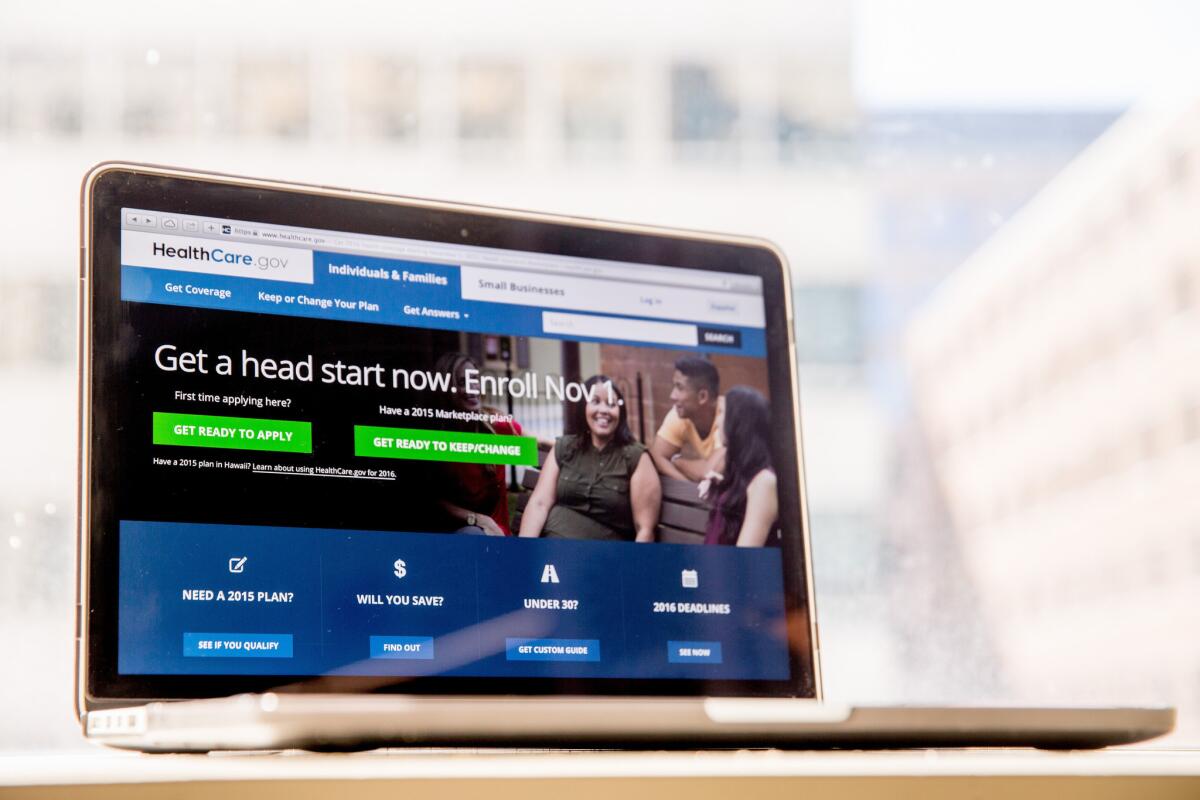The scramble to get consumers to buy the right health coverage through Obamacare

Consumers in 38 states can now buy health insurance through the federal marketplace at HealthCare.gov. The next open enrollment period starts Sunday.
State and federal health officials, facing growing concerns about the cost of insurance plans offered through the Affordable Care Act, are scrambling to deploy new Web-based tools to help Americans find the most economical coverage.
This fall, state and federal insurance marketplaces created by the law, including in California, plan to offer consumers more comprehensive ways to compare health plans, check physician networks and estimate their total healthcare costs.
“People desperately need help,” said Robert Krughoff, president of Consumers’ Checkbook, a nonprofit that has helped several states develop new tools for their marketplaces.
The push has taken on added urgency as consumers face skyrocketing out-of-pocket medical bills, even as they struggle to understand trade-offs among premiums, deductibles and financial aid provided by the health law.
NEWSLETTER: Get the day’s top headlines from Times Editor Davan Maharaj >>
That is pushing the issue of healthcare costs back onto the political agenda, with a growing number of presidential hopefuls promising new efforts to protect consumers.
The health law’s third open enrollment period – and the last before the 2016 presidential election – kicks off Sunday with officials hoping to enroll at least 11 million people.
Although the law’s coverage expansion has already produced a historic reduction in the nation’s uninsured, an estimated 10 million Americans who are eligible for marketplace coverage have not enrolled. Many are fearful about the costs or bewildered by the coverage options, surveys suggest.
“We know that buying insurance is complicated,” said Kevin Counihan, who oversees insurance marketplaces run by the U.S. Department of Health and Human Services. “One of the things we’ve learned is … some folks have passed up on significant and material benefits.”
The Obama administration recently downgraded its estimates for expanding enrollment in 2016, citing in part the challenge of reaching new customers.
The most promising new tools will allow shoppers to estimate the total cost of health plans being offered on marketplaces by factoring in out-of-pocket costs such deductibles and co-pays, as well as premiums.
Very often, these calculators show, the plan with the lowest premium is not the best value, especially for people with medical conditions that may require frequent doctor visits or multiple prescriptions.
The health law was supposed to demystify shopping for health insurance. By some measures, it has substantially simplified the process, despite the rocky debut of HealthCare.gov two years ago.
Plans sold on insurance marketplaces – including both the federal HealthCare.gov marketplace now used in 38 states and state-run marketplaces such as Covered California – now must offer a basic set of benefits.
Insurers can no longer cap what they will pay or exclude coverage of select medical conditions. Nor can insurers put consumers through the bewildering and often frustrating process of medical underwriting.
The online marketplaces also allow consumers to stack up health plans against one another, allowing comparisons based on monthly premiums, deductibles and other metrics, similar to shopping for airfares or hotel rooms.
The plans are divided into four categories – Platinum, Gold, Silver and Bronze – with higher metal plans typically featuring lower deductibles and higher premiums and lower metal plans featuring lower premiums and higher deductibles.
Even with the new standards, however, millions of consumers still struggle to understand their options, surveys and other research indicate.
In Kentucky, considered one of the most successful marketplaces, state officials found that many healthy consumers were buying high-premium Gold and Platinum plans, though they rarely went to the doctor.
And many sick people were paying far more than necessary because they selected low-premium Bronze plans that had very high deductibles.
“Many Kentuckians are overwhelmed with the number of qualified health plan options to choose from and oftentimes do not select the plan that best meets their needs,” said Carrie Banahan, who heads the marketplace.
The cost to consumers of these kinds of miscalculations can be huge.
In the District of Columbia, for example, a 45-year-old non-smoker researching health insurance options could find a Bronze health plan this year for as little as $122 a month, or $1,484 a year.
That might be a good choice for a healthy consumer who rarely goes to the doctor.
But if that same shopper was in fair health – suggesting he or she might need to go to the doctor frequently – and was expecting a major medical procedure, such as a knee replacement – that low-premium health plan could be very costly because the plan has a $6,000 deductible.
In fact, factoring in out-of-pocket costs, this Bronze plan would cost an estimated $7,174 a year, according to a calculator offered by D.C. Health Link, Washington’s marketplace.
The more economical choice for this consumer would be a health plan with a much higher premium but lower deductible.
In this case, a plan with a $235-a-month premium but no deductible would cost an estimated $3,870 a year, according to the calculator.
Many consumer advocates have been calling for these kinds of calculators, which typically ask shoppers to answer a few basic questions about their health and then ranks available plans by estimated total cost, rather than by monthly premium, as plans have traditionally been ranked.
California also offers a calculator, as will Kentucky and Minnesota.
The federal government will also operate a calculator on HealthCare.gov for residents of the 38 states that rely on the federally run marketplace in 2016, including Illinois, Florida, Texas and Virginia.
Illinois’ state government will operate an additional calculator at GetCovereredIllinois.gov.
In addition, a growing number of marketplaces – including Colorado, Maryland and the District of Columbia – will allow consumers to screen out health plans that do not include their preferred doctors.
Federal officials are working to provide a similar tool on HealthCare.gov. They also plan to allow shoppers to screen for health plans that cover their prescription drugs.
But troubles validating provider directories and drug formularies have delayed the roll-out of these tools. HealthCare.gov officials said they should be ready sometime after open enrollment begins Sunday.
These new tools should go a long way to simplifying the process of buying insurance, said Eric Gascho, assistant vice president of the National Health Council, a coalition of patient advocacy groups that has been pushing for years for better consumer support tools.
“What we are going to see in the next open enrollment won’t be perfect,” Gascho said. “But it will be a big step in the right direction.”
ALSO
L.A. teachers weigh in on classroom discipline in reaction to South Carolina girl’s case
Nintendo unveils ‘Miitomo,’ its first game for smartphones
IBM to acquire the Weather Co.’s digital assets, repositioning for the digital era







